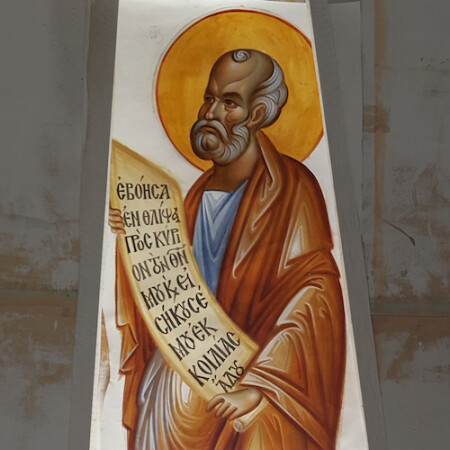The Images of the Prophets in the Dome of the
Shrine of Saint Nicholas
 |
 |
By Bishop Joachim of Amissos
Bishop Joachim of Amissos is an internationally recognized expert in Byzantine Iconography and is the Director of the Archbishop Iakovos Library at Hellenic College/Holy Cross.
Depictions of Prophets were included in church iconographic programs at least as early as the 6th century, as seen in the various mosaic decorations of the Byzantine churches of Ravenna. After the period of Iconoclasm (ending in 843), when Byzantine ecclesiastical architecture emerged most characteristically as a centralized plan surmounted by a prominent dome at its core, it became customary to place images of the Prophets in the dome, below the central medallion bust-length-figure of Christ, usually referred to as the Pantokrator. The dome, the highest point within the church structure, became associated with heaven and thereby was reserved for the depiction of the Lord and His ministering servants. Depending on the architectural structure of a church dome, the images of the Prophets, depicted standing, are placed between the ribs that radiate centrally from the center of the dome and central image of the Christ Pantokrator, or they are placed on the walls of the upright drum of the dome.
The images of the Prophets in the dome reflect a sophisticated planning in church iconographic programs. The Old Testament Prophets serve as intermediaries between the Word of God above them and humanity on earth below. In the Orthodox Church, their role is primarily understood as heralds of the promise of the Incarnation of the Lord. In the text of the Synodikon of Orthodoxy (843), the commemorative text celebrating the final Iconophile victory over the Iconoclasts, the Old Testament prophetic visions and prefigurations related to the Incarnation are stressed, since the reality of the Incarnation was the central defense for the legitimization of sacred icons.
Also after Iconoclasm, the Prophetologion was developed-the liturgical book that gathered together the excerpts of texts from the various Old Testament prophetic books that were read at the Great Vespers of the liturgical feasts of the year commemorating the life of Christ and that of the Theotokos, those for Great Lent and Holy Week and for the celebrations of major Saints. Often the Prophets are depicted with open scrolls bearing portions of texts taken directly from the readings found in the Prophetologion, thus reinforcing the connection between Sacred Scripture, liturgical worship and iconography.
Historically, the texts found on the Prophets’ scrolls in the dome could vary, depending on the dedication of the church, or reflecting a general theme such as the Incarnation, judgment, God’s mercy, or various combinations of these themes. The Shrine of Saint Nicholas will have images of 20 Prophets, one placed in alternating ribs of the 40 ribs emanating from the center of the dome. Some, like Aaron, the prophet-priest, depict him with his customary attributes: the golden jar that held the manna from heaven (Exodus 16:33-34) and the rod that blossomed miraculously (Numbers 17:8): both understood as prefigurations of the Theotokos and her role in the Incarnation; while others, such as the Prophet Jonah, who holds an open scroll bearing an excerpt from his prayer when he was in the belly of the whale: “I cried in my affliction to the Lord my God, and He hearkened unto me, even to my cry out of the bowels of hell” (Jonah 2:2), anticipating God’s salvific intervention for Jonah in a time of extreme danger and serving as a prefiguration of Christ’s own Resurrection from the dead. The fulfillment of the Old Testament prophetic visions of the Incarnation and Resurrection in the person of Jesus Christ grants to us the possibility of our own participation in the Resurrection and for those who so tragically lost their lives at Ground Zero on 9/11. The Shrine of Saint Nicholas will be a visible emblem of this message of hope and comfort.